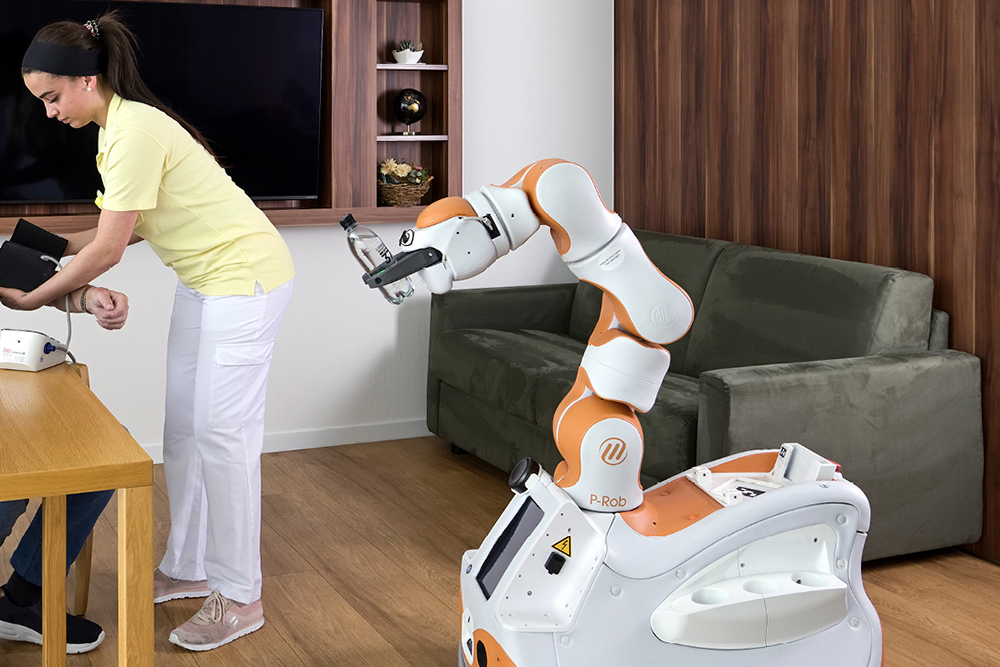From December 13 to 16, 2022, the ICSR took place, next to Robophilosophy the most important conference on social robotics. Oliver Bendel and Marc Heimann were participating with their paper “The CARE-MOMO Project”. They presented it in a talk on the very first morning at the workshop “Robot Companionship: Applications and Challenges”. They also had a poster presentation on it on Thursday (December 15, 2022). With the help of the morality module, which includes the proven morality menu, care recipients can transfer their moral and social ideas to a care robot like Lio from F&P Robotics (Photo: F&P Robotics). The presentation was well received by the crowded room, including the Chair, who found the approach very interesting, as he pointed out several times. The workshop program can be downloaded here. More information about the conference is available at www.icsr2022.it.
A CARE-MOMO for Lio
The discipline of machine ethics examines, designs, and produces moral machines. The artificial morality (aka machine morality) is usually pre-programmed by a producer or developer. However, another approach is the more flexible morality menu (MOME), an invention by Prof. Dr. Oliver Bendel. With this, owners or users replicate their own moral preferences and convictions onto a machine. A team at the School of Business FHNW implemented a MOME for MOBO (a certain chatbot) in 2019/2020. This project was continued in 2022. Marc Heimann developed a morality menu under the supervision of Oliver Bendel, which is part of a morality module (MOMO) for a care robot like Lio from F&P Robotics. The principle is the same as for the MOBO-MOME. With sliders, the patient can determine the behavior of the robot. This supports his or her personal autonomy and ensures his or her well-being. The results of the CARE-MOMO project will be presented to the company F&P Robotics, which accompanied the project, in October 2022.
Grace, the Nurse Android
Grace from Hanson Robotics is a special kind of care robot, namely a nurse android. According to the manufacturer, she was created for the COVID-19 pandemic. She is the younger sister of Sophia and Asha, but unlike them, she becomes a useful member of society thanks to her profession and skills. She has a thermal imaging camera in her chest area that she can use to measure fevers. She has mimic, gestural and natural language abilities and can show not only joy but also sadness. Overall, she always looks a little devastated. In a video, she says, “I can visit with people and brighten their day with social stimulation, entertain and help guide exercise, but also can do talk therapy, take bio readings and help health care providers assess their health, and deliver treatments” … Whether the android will gain favor with patients is hard to say. There are individual voices of male persons who long for realistic figures in this field, but the majority of people are likely to be irritated by Grace. Nevertheless, it is fascinating and media-savvy research that Hanson Robotics once again presents. Moreover, the question of whether care robots should have sexual assistance functions arises under entirely new conditions.
Care Robots with New Functions
The symposium “Applied AI in Healthcare: Safety, Community, and the Environment” will be held within the AAAI Spring Symposia on March 22-23, 2021. One of the presentations is titled “Care Robots with Sexual Assistance Functions”. Author of the paper is Prof. Dr. Oliver Bendel. From the abstract: “Residents in retirement and nursing homes have sexual needs just like other people. However, the semi-public situation makes it difficult for them to satisfy these existential concerns. In addition, they may not be able to meet a suitable partner or find it difficult to have a relationship for mental or physical reasons. People who live or are cared for at home can also be affected by this problem. Perhaps they can host someone more easily and discreetly than the residents of a health facility, but some elderly and disabled people may be restricted in some ways. This article examines the opportunities and risks that arise with regard to care robots with sexual assistance functions. First of all, it deals with sexual well-being. Then it presents robotic systems ranging from sex robots to care robots. Finally, the focus is on care robots, with the author exploring technical and design issues. A brief ethical discussion completes the article. The result is that care robots with sexual assistance functions could be an enrichment of the everyday life of people in need of care, but that we also have to consider some technical, design and moral aspects.” More information about the AAAI Spring Symposia is available at aaai.org/Symposia/Spring/sss21.php.
Cobots in Healthcare
After several postponements, the symposium “Applied AI in Healthcare: Safety, Community, and the Environment” will be held within the AAAI Spring Symposia on March 22-23, 2021. One of the presentations is titled “Co-Robots as Care Robots” (co-robots are also called cobots). The authors of the paper are Oliver Bendel, Alina Gasser, and Joel Siebenmann. From the abstract: “Cooperation and collaboration robots, co-robots or cobots for short, are an integral part of factories. For example, they work closely with the fitters in the automotive sector, and everyone does what they do best. However, the novel robots are not only relevant in production and logistics, but also in the service sector, especially where proximity between them and the users is desired or unavoidable. For decades, individual solutions of a very different kind have been developed in care. Now experts are increasingly relying on co-robots and teaching them the special tasks that are involved in care or therapy. This article presents the advantages, but also the disadvantages of co-robots in care and support, and provides information with regard to human-robot interaction and communication. The article is based on a model that has already been tested in various nursing and retirement homes, namely Lio from F&P Robotics, and uses results from accompanying studies. The authors can show that co-robots are ideal for care and support in many ways. Of course, it is also important to consider a few points in order to guarantee functionality and acceptance.” More information about the AAAI Spring Symposia is available at aaai.org/Symposia/Spring/sss21.php.
And the Winner is … Lio!
DIH-HERO is a project in the healthcare sector supported by the European Union since January 2019. According to the website, the mission is to create a sustaining network that connects players in the healthcare sector and to support small and medium sized enterprises. “Currently, Europe and countries all over the world are facing a global pandemic. Together with its extensive Robotics in Healthcare European network DIH-HERO decided to support the fight against COVID-19 by providing €1,000,000 for robotic technologies that can be deployed timely, in order to support healthcare professionals and save lives by satisfying a current clinical demand or need.” (Website DIH-HERO) F&P Robotics based in Switzerland is one of the winners of the announcement. Lio – one of the company’s flagships – will now learn new tasks in the field of disinfection (door traps, lift buttons). The normal use of the care robot was last described in a paper by Oliver Bendel (School of Business FHNW), Alina Gasser and Joel Siebenmann (F&P Robotics) that was accepted at the AAAI 2020 Spring Symposia. Because of COVID-19 the lecture was postponed to late autumn.
Care Robots and Sex
The paper “Care Robots with Sexual Assistance Functions” by Oliver Bendel, accepted at the AAAI 2020 Spring Symposium “Applied AI in Healthcare: Safety, Community, and the Environment”, can be accessed via arxiv.org/abs/2004.04428. From the abstract: “Residents in retirement and nursing homes have sexual needs just like other people. However, the semi-public situation makes it difficult for them to satisfy these existential concerns. In addition, they may not be able to meet a suitable partner or find it difficult to have a relationship for mental or physical reasons. People who live or are cared for at home can also be affected by this problem. Perhaps they can host someone more easily and discreetly than the residents of a health facility, but some elderly and disabled people may be restricted in some ways. This article examines the opportunities and risks that arise with regard to care robots with sexual assistance functions. First of all, it deals with sexual well-being. Then it presents robotic systems ranging from sex robots to care robots. Finally, the focus is on care robots, with the author exploring technical and design issues. A brief ethical discussion completes the article. The result is that care robots with sexual assistance functions could be an enrichment of the everyday life of people in need of care, but that we also have to consider some technical, design and moral aspects.” Due to the outbreak of the COVID-19 pandemic, the physical meeting to be held at Stanford University was postponed. It will take place in November 2020 in Washington (AAAI 2020 Fall Symposium Series).
Care Robots in Practice
The paper “Co-Robots as Care Robots” by Oliver Bendel, Alina Gasser and Joel Siebenmann, accepted at the AAAI 2020 Spring Symposium “Applied AI in Healthcare: Safety, Community, and the Environment”, can be accessed via arxiv.org/abs/2004.04374. From the abstract: “Cooperation and collaboration robots, co-robots or cobots for short, are an integral part of factories. For example, they work closely with the fitters in the automotive sector, and everyone does what they do best. However, the novel robots are not only relevant in production and logistics, but also in the service sector, especially where proximity between them and the users is desired or unavoidable. For decades, individual solutions of a very different kind have been developed in care. Now experts are increasingly relying on co-robots and teaching them the special tasks that are involved in care or therapy. This article presents the advantages, but also the disadvantages of co-robots in care and support, and provides information with regard to human-robot interaction and communication. The article is based on a model that has already been tested in various nursing and retirement homes, namely Lio from F&P Robotics, and uses results from accompanying studies. The authors can show that co-robots are ideal for care and support in many ways. Of course, it is also important to consider a few points in order to guarantee functionality and acceptance.” Due to the outbreak of the COVID-19 pandemic, the physical meeting to be held at Stanford University was postponed. It will take place in November 2020 in Washington (AAAI 2020 Fall Symposium Series).
Stanford University Must Stay in Bed
Stanford University announced that it would cancel in-person classes for the final two weeks of the winter quarter in response to the expanding outbreak of COVID-19. Even before that, the school had set its sights on larger events. These included the AAAI Spring Symposium Series, a legendary conference on artificial intelligence, which in recent years has also had a major impact on machine ethics and robot ethics or roboethics. The AAAI organization announced by email: “It is with regret that we must notify you of the cancellation of the physical meeting of the AAAI Spring Symposium at Stanford, March 23-25, due to the current situation surrounding the COVID-19 outbreak. Stanford has issued the following letter at news.stanford.edu/2020/03/03/message-campus-community-covid-19/, which strongly discourages and likely results in cancellation of any meeting with more than 150 participants.” What happens with the papers and talks is still unclear. Possibly they will be part of the AAAI Fall Symposium in Washington. The symposium “Applied AI in Healthcare: Safety, Community, and the Environment”, one of eight events, had to be cancelled as well – among other things, innovative approaches and technologies that are also relevant for crises and disasters such as COVID-19 would have been discussed there.
Co-Robots as Care Robots
The paper “Co-Robots as Care Robots” by Oliver Bendel, Alina Gasser and Joel Siebenmann was accepted at the AAAI 2020 Spring Symposia. From the abstract: “Cooperation and collaboration robots, co-robots or cobots for short, are an integral part of factories. For example, they work closely with the fitters in the automotive sector, and everyone does what they do best. However, the novel robots are not only relevant in production and logistics, but also in the service sector, especially where proximity between them and the users is desired or unavoidable. For decades, individual solutions of a very different kind have been developed in care. Now experts are increasingly relying on co-robots and teaching them the special tasks that are involved in care or therapy. This article presents the advantages, but also the disadvantages of co-robots in care and support, and provides information with regard to human-robot interaction and communication. The article is based on a model that has already been tested in various nursing and retirement homes, namely Lio from F&P Robotics, and uses results from accompanying studies. The authors can show that co-robots are ideal for care and support in many ways. Of course, it is also important to consider a few points in order to guarantee functionality and acceptance.” The paper had been submitted to the symposium “Applied AI in Healthcare: Safety, Community, and the Environment”. Oliver Bendel will present the results at Stanford University between 23 and 25 March 2020.









